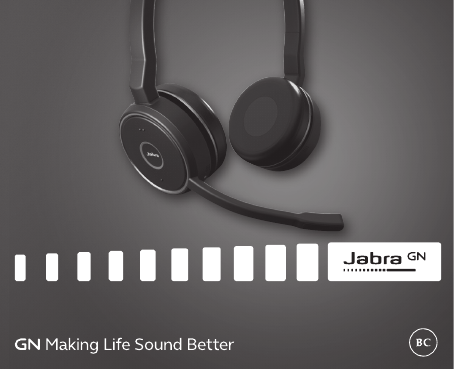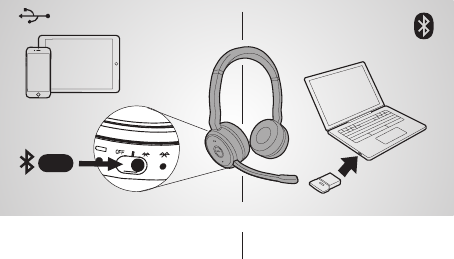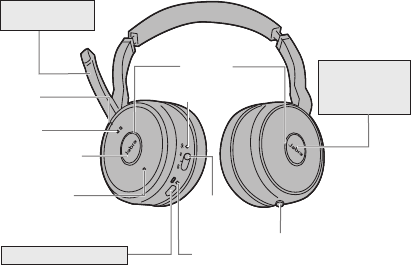GN Audio USA HSC040W Bluetooth Headsets User Manual
GN Netcom Inc Bluetooth Headsets Users Manual
Users Manual

Jabra
Evolve 75
81-04124 A
jabra.com/evolve75
NEED MORE HELP?
For all support go to jabra.com/support

Quick start guide
Jabra
Evolve 75

Insert the USB dongle into your PC.
The headset and the USB dongle are
pre-paired.
Hold the Bluetooth switch for 3 seconds.
Wear the headset and follow the
voice-guided pairing instructions.
How to pair
using Bluetooth or USB dongle
3 sec.

Busylight
Battery
LED
Bluetooth
LED
USB charging port
On/o/
Bluetooth
switch
Volume up
button
Volume down
button
Answer/end call
button
Active Noise Cancellation
button
Mute
button
Microphone boom-arm
Listen-in
button
Hear your
surroundings
without taking o
your headset
Approx. 3 hours to charge
Up for mute on &
down for mute o
How to use
How to pair
using Bluetooth or USB dongle

Complies with
IMDA Standards
DA102350
CIDF15000193
© 2017 GN Audio A/S. All rights reserved. Jabra® is a trademark
of GN Audio A/S. The Bluetooth® word mark and logos are regis-
tered trademarks owned by the Bluetooth SIG, Inc. and any use of
such marks by GN Audio A/S is under license.
Made in China
Model: HSC040W
FCC ID: BCE-HSC040W
IC: 2386C-HSC040W
Federal Communication Commission (FCC) Radiation Exposure Statement:
Power is so low that no RF exposure calculation is needed.
FCC statements:
This device complies with part 15 of the FCC rules. Operation is subject to the
following two conditions: (1) this device may not cause harmful interference, and (2)
this device must accept any interference received, including interference that may
cause undesired operation.
NOTE: The manufacturer is not responsible for any radio or TV interference caused
by unauthorized modifications or changes to this equipment. Such modifications or
changes could void the user’s authority to operate the equipment.
NOTE: This equipment has been tested and found to comply with the limits for a
Class B digital device, pursuant to part 15 of the FCC Rules. These limits are designed
to provide reasonable protection against harmful interference in a residential
installation. This equipment generates uses and can radiate radio frequency energy
and, if not installed and used in accordance with the instructions, may cause harmful
interference to radio communications. However, there is no guarantee that
interference will not occur in a particular installation. If this equipment does cause
harmful interference to radio or television reception, which can be determined by
turning the equipment off and on, the user is encouraged to try to correct the
interference by one or more of the following measures:
‐ Reorient or relocate the receiving antenna.
‐ Increase the separation between the equipment and receiver.
‐Connect the equipment into an outlet on a circuit different from that to which the
receiver is connected.
‐Consult the dealer or an experienced radio/TV technician for help.
This equipment complies with FCC RF radiation exposure limits set forth
for an uncontrolled environment.
This transmitter must not be co-located or operating in conjunction with any other
antenna or transmitter.
IC Radiation Exposure Statement:
The SAR limit of IC is 1.6 W/kg averaged over one gram of tissue. Device
types HSC040W has also been tested against this SAR limit.
The highest SAR value reported under this standard during product certification for
use when properly for head is 0.020 W/kg.
IC statement:
This Class B digital apparatus complies with Canadian ICES‐003.
Cet appareil numérique de la classe B est conforme à la norme NMB‐003 du Canada.
This device complies with Industry Canada license‐exempt RSS standard(s).
Operation is subject to the following two conditions:
(1) this device may not cause interference, and
(2) this device must accept any interference, including interference that may cause undesired
operation of the device.
Cet appareil est conforme avec Industrie Canada RSS exemptes de licence standard(s).
Son fonctionnement est soumis aux deux conditions suivantes:
(1) cet appareil ne peut pas provoquer d'interférences, et
(2) cet appareil doit accepter toute interférence, y compris celles pouvant causer un
mauvais fonctionnement de l'appareil.